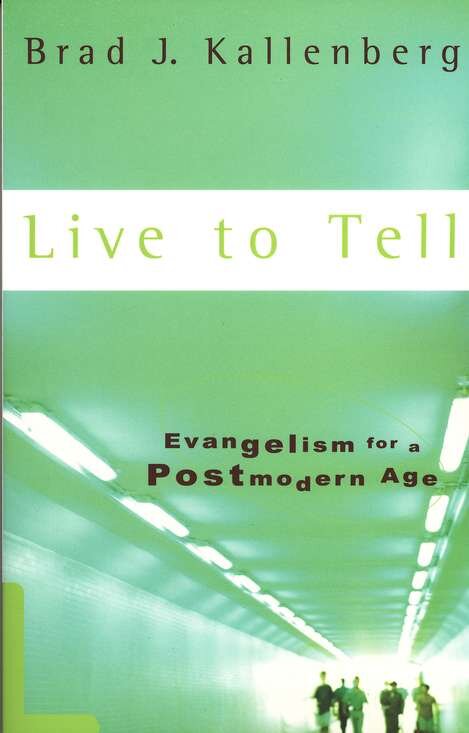Brad J. Kallenberg, Live to Tell: Evangelism in a Postmodern Age. Brazos Press, 2002.
Reference in: Theology and Practice of Evangelism: Missional/Missio Dei
LifeandLeadership.com Summary
Since evangelism from the Missional/Missio Dei perspective is partially a reaction to the postmodern cultural shift, it makes sense for someone to describe the philosophical underpinnings of the postmodern climate and how this relates to evangelism. Kallenberg works from his academic background to make this contribution. A heavier version of the same genre is Chilcotte and Warner, The Study of Evangelism.
In the preface, He argues,
Church history from the New Testament to the present shows that theology has always borrowed from philosophy to make its point with the regnant culture. …Whether this is done explicitly (e.g. Aquinas’s use of Aristotle) or implicitly (e.g. Augustine’s use of Plato), such borrowing is always risky business, but a necessary one if we are to communicate the gospel. The only question that remains is whether we borrow wisely and with open eyes.
He suggests that in the most recent era, the church borrowed significantly from modernity, even to the extent of overdose, and that postmodern philosophy, even with its dangers, may serve as a helpful corrective to help us “recast the way we do ministry in the contemporary culture.” This is a necessary part of what missiologists call contextualization, i.e. “becoming students of the host culture so we can discover how God’s Spirit intends the gospel to become embodies in the new era.” So he says, “what follows is my first attempt at expressing what it might mean to sing the gospel story in a postmodern key.” (13)
In the first chapter, he surveys the postmodern philosophical environment, extracting elements he believes are useful to the task of evangelism in this era. Those not schooled in philosophy may get lost here, but Kallenberg does a good job expressing things accessibly for the uninitiated. Chapter two discusses how this postmodern lens helps us understand conversion as “a change of one’s social identity, the acquisition of a new conceptual language, and the shifting of one’s paradigm.” (32) Each of the next chapters develops these three ideas. Chapter three discusses the “change of one’s social identity” by elevating the importance of seeing evangelism as a communal practice in the new context, over against a more individualistic view of salvation in the modern era. Chapter four discusses “the acquisition of a new conceptual language,” where he presents several actual stories of conversion and how the persons involved grew to embrace their new identity, but in language more expressive of their postmodern origins than in terms most church folk regard as standard. Chapter five takes up the “shifting of one’s paradigm,” showing how the metaphor of narrative, story, and journey capture the postmodern ethos.
This is an excellent description of the evangelistic heartbeat of the emerging church. It is an honest look at how Christians in all times have used the best philosophical tools offered by their cultures to find ways of communicating the gospel in their time and place. Christians in the postmodern turn can do no different. To do otherwise risks casting the gospel in terms so irrelevant as to appear nonsensical to those we wish to reach. On the other hand, it is important to appropriate the tools of philosophy judiciously. Kallenberg makes a good attempt at this. Yet I would suggest balancing this volume with others from the Evaluating-Emergent perspective. They offer a different take on how to engage the task of contextualization. See also the interpretive essay on Evangelism in the Postmodern Ethos.
From the Publisher
In recent years, countless Christians have found evangelism a difficult and even baffling scriptural mandate. Those we encounter, particularly young people, are often entirely unfamiliar with the basics of the gospel. Traditional means of communicating the faith, from cold-calling to mass-mailings, simply no longer speak the language of the culture.
Brad Kallenberg recognizes that evangelism, even in our own backyard, has become a cross-cultural task. Like missionaries serving in foreign countries, we must become “students of the host culture.” Much more than a “sinner’s prayer,” conversion requires a change of social identity.
Indeed, becoming a follower of Christ involves gaining fluency in the language of Christianity by “engaging in an entirely different form of living with others, and treating evangelism as a communal practice.” If we expect to be heard, we need to understand the philosophical underpinnings of our society; we must, in Kallenberg’s words, learn to “sing the gospel story in a postmodern key.”
Live to Tell is a compassionate, wise, and necessary guide. It offers both theoretical insight and practical strategies for reaching postmodern people with the gospel. Pastors, youth pastors, campus ministers, and all witnessing Christians will find this book encouraging and enlightening.
About the Author
Brad J. Kallenberg is assistant professor of religious studies at the University of Dayton (Ohio). He has been actively involved in evangelism since his teen years, and has devoted a decade of his life to full-time campus-based ministry and evangelism.
***For additional information on this resource, including reviews, click the bookstore links. Check the reference at page top or the links below for resource guides on related topics.***
Related Areas
See Other Resources on Evangelism:
See Resources on Over 100 Areas of Ministry Leadership:


